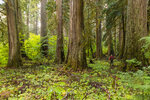
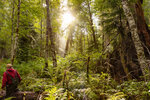

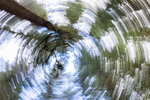
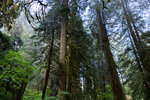

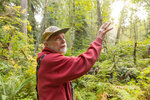
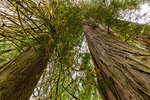

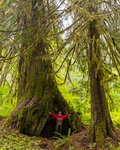
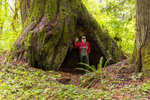
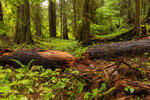
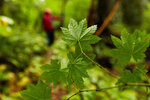
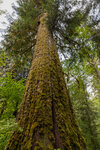
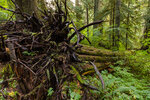

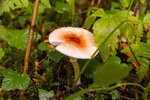
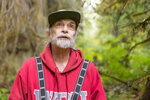
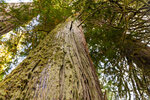
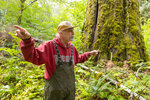
By the time the Renaissance began, the oldest trees in the Grove of the Matriarchs may have already turned 300.
Today, “old growth” generally refers to trees that are older than 100 years.
This grove, just a short walk off a Forest Road south of Randle, has a 47-foot circumference western red cedar that John Squires, 64, of Packwood, believes to be between 700 and 1,000 years old. Surrounding that, there are more than a dozen other cedars and monstrous Douglas fir trees.
Its name is a play off the Grove of the Patriarchs in Mount Rainier National Park — these trees are as glorious, yet less beloved and much more wild. Squires said he first heard the name from some “enviro” friends, also known as environmentalists.
Twenty years ago, Squires was a founding member of the Pinchot Partners, a collaborative — but not always cooperative — group of representatives from the Cascade Forest Conservancy, the communities of Packwood and Randle, the timber industry, the Forest Service and the Cowlitz Indian Tribe.
In celebration of the organization's anniversary, he brought the team out to the grove two weeks ago. He brought reporters from The Chronicle late last week.
The only thing I could find about this place online was another Chronicle story from 2018 that also featured Squires.
The grove has the largest trees I’ve seen in Washington state. Alex Brown, a reporter who wrote the previous article on this grove, said the same thing.
Squires likes to be in the woods. That’s obvious by his chosen profession as a firewood concessionaire for campers at Mount Rainier, but it’s not his only motive with these field trips. This ancient cathedral is his most illustrative prop to help people think about forestry in terms of centuries and millennia, not decades.
“This is the goal. I want, in the future, this forest to have lots of places like this,” Squires said. “And people to be able to experience it, because it’s definitely spiritual.”
Growing up in Packwood, Squires remembers trees of this size being hauled from the forest as individual loads, large enough for a single load. Until the early 2000s, he said, Congress told the U.S. Forest Service how much wood to cut and when.
“I had believed that we would cut it all,” Squires said. “And it would be gone.”
His “epiphany” came from fishing Smith Creek with his father growing up. The trees were huge. There were cool, deep plunge pools, fat with trout. Squires, his brother and their dad, with a 12-fish-per-person limit, would come home with 36 fish.
At age 13, upon arrival at this spot, Squires saw “they had literally logged all the way across, right to the streams. Pulled all the logs that used to make the pools in the stream out. … There were no fish. That was sort of when I realized that this isn’t cool.”
If the area were logged responsibly, he said, it could have been suitable for fish and timber profits. But it wasn’t.
In the early 1990s, Squires was chosen to sit on the Forest Service’s first federal advisory committee on implementation of the Clinton administration’s Northwest Forest Plan. He was chosen as an “other” category member of the public alongside elected officials, environmental lawyers and business representatives. The category felt a bit condescending, he said.
The plan came to encompass Northwest region Forest Service practices of all kinds, though, some say it was originally thought up to tackle growing concerns over the northern spotted owl.
With protections for the owl came the end of logging that Squires called “sort of like mining. You’d have these boom towns, and bust.”
But irresponsible forestry isn’t limited to irresponsible logging. As the Pinchot Partners’ “about” statement phrases it, neglect, overstocked plantations, lack of structural complexity — these are all examples where “lack of active management” was also hindering species restoration.
Now, the Forest Service faces a new challenge.
“It’s a capacity issue. You need more —” Squires said before stomping his boot on the ground, finishing his sentence.
Ideally, the Grove of the Matriarchs would have room for parking, staff who cared for it and visitors who were inspired to care for the forest. Then, those visitors could spend money at the Big Bottom Roadhouse on the way out.
Until there is that kind of management, though, Squires is hesitant to broadcast the Matriarchs’ coordinates, citing people pitching tents on already threatened wildflower meadows at Mount Rainier’s Sunrise earlier this summer.
If the Forest Service and all the forest’s shareholders can lead with education and care for the woods, he hopes the day can come.
“I know it’s hard, and you’re not going to get everybody. But, if you get enough people, especially young people … to understand really what an ecosystem is and the harm they can do by loving it,” Squires said, adding, “They will be better stewards to it.”